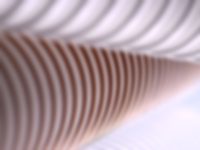Not every hose is suitable for transporting foodstuffs. Only hoses that comply with strict regulations and guidelines may be used to transport coffee, sugar or even milk powder from A to B.
For many years, Masterflex has been offering <link www.masterflex.de/schlaeuche-verbindungssysteme/artikelliste/lebensmittelschlaeuche-und-pharmaschlaeuche.6_7_746.html - - ‘Opens internal link in current window’>certified food-safe hoses </link>and matching high-quality connection and coupling elements for many years. ‘We adapted to the new requirements at an early stage,’ says Joachim Jacobi, project manager for the development of FOOD hoses at Masterflex. ‘And we are now the first company on the market to guarantee the new standard in accordance with Regulation No. 10/2011 with regard to food suitability for our permanently antistatic FOOD hoses. The wall of our FOOD-A hoses is permanently antistatic Ro < 109 ohms and is therefore conductive in accordance with TRBS 2153 (ATEX).’ After several years of transition, this EU regulation will be the benchmark standard for companies in the food processing industry without exception from January 2016. The other hoses in the Master-PUR FOOD series have already been meeting this standard since 2012.
This means that all FOOD hoses from the Masterflex Group can be used to transport foodstuffs ranging from potato starch and sugar to frozen foods and even milk powder for baby food. ‘This allows us to offer our customers not only the high quality they have come to expect, but also maximum legal certainty,’ says Jacobi.
Since 2011, the food processing industry has been regulated not only by Framework Regulation EC 1935/2004 and Regulation EC 2023/2006 on ‘good manufacturing practice’, but above all by EU Regulation No. 10/2011 on the ‘placing on the market of plastic materials and articles’, also known as the ‘Plastics Implementation Measure’ (PIM), which regulates the activities of the food processing industry.
The aim of the regulation is to consolidate the various regulations on this subject within the European Union. For example, the provisions on migration testing and the use of food simulants have been amended. In addition, contact times and contact temperatures have been redefined and the regulation extended to include multi-layer materials and multi-layer composite materials.
‘All materials used for our food hoses therefore comply with the demanding national and international food regulations and are ideally suited for use in the food industry,’ says Jacobi. This has been confirmed and certified by an independent institute. In addition to the three standards mentioned above, Masterflex food hoses also comply with the guidelines of the FDA (US Food and Drug Administration) and the German Food and Feed Code (LFGB).
By meeting these standards, Masterflex's FOOD-A spiral hose series is the first to comply with EU Regulation 10/2011 and FDA guidelines. ‘Demand and interest in our FOOD hose series is correspondingly high,’ says Christian Horstkötter, Sales Manager for Masterflex.
The test report for the permanently antistatic Master-PUR FOOD A hose series with stainless steel spiral according to 10/2011 is available. Not only was the material that is subsequently processed tested, but also a complete antistatic food hose.
Masterflex uses stainless steel wire in all FOOD hoses. The stainless steel wire spiral ensures that the conveying medium remains suitable for food even if the wall material beneath the wire spiral wears away. ‘Thanks to our optimised hose profile, there are hardly any material residues in FOOD hoses, they are much easier to clean and can also be installed bi-directionally,’ says Horstkötter. The permanently antistatic FOOD-A hoses will be available from Masterflex from 1 January 2016.





